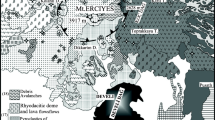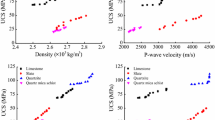Abstract
This article adopts three soft computing techniques including support vector machine (SVM), least square support vector machine (LSSVM) and relevance vector machine (RVM) for prediction of status of epimetemorphic rock slope. The input variables of SVM, LSSVM and RVM are bulk density, height, inclination, cohesion and internal friction angle. There are 53 datasets which have been used to develop the SVM, LSSVM and RVM models. The developed SVM, LSSVM and RVM give equations for prediction of status of epimetemorphic rock slope. The performance of SVM, LSSVM and RVM is 100%. A comparative study has been presented between the developed SVM, LSSVM and RVM. The results confirm that the developed SVM, LSSVM and RVM are effective tools for prediction of status of epimetemorphic rock slope.
Similar content being viewed by others
References
Chen C, Xiao Z, Zhang G. Stability assessment model for epimetamorphic rock slopes based on adaptive neuro-fuzzy inference system [J]. Journal of Geotechnical Engineering Bund A, 2011, 16: 93–107.
Fellenius W. Calculation of stability of earth dams [D]. Stockholm, Sweden: Royal Technical University, 1936, 4–445.
Bishop A W. The use of slip circle in the stability of slopes [J]. Geotechnique, 1955, 5(1): 7–17.
Bishop A W, Morgenstern N R. Stability coefficients for earth slopes [J]. Geotechnique, 1960, 10(4): 129–150.
Morgenstern N R, Price V E. The analysis of the stability of general slip surfaces [J]. Geotechnique, 1965, 15(1): 79–93.
Michalowski R L. Limit analysis of slopes subjected to pore pressure [C]//Proceedings of Conference on Computer Methods and Advances in Geomech. Rotterdam, Netherlands: Balkema, 1994.
Michalowski R L. Slope stability analysis: A kinematical approach [J]. Geotechnique, 1995, 45(2): 283–293.
Michalowski R L. A Stability charts for uniform slopes [J]. Journal of Geotechnical and Geoenvironmental Engineering, 2002, 128(4): 351–355.
Sah N K, Sheorey P R, Upadhyaya L N. Maximum likelihood estimation of slope stability [J]. International Journal of Rock Mechanics and Mining Sciences and Geomechanics, 1994, 31(1): 47–53.
Griffiths D V, Lane P A. Slope stability analysis by finite elements [J]. Geotechnique, 1999, 49(3): 387–403.
Yang C X, Tham L G, Feng X T, et al. Two-stepped evolutionary algorithm and its application to stability analysis of slopes [J]. Journal of Computing in Civil Engineering, 2004, 18(2): 145–153.
Kumar J, Samui P. Determination for layered soil slopes using the upper bound limit analysis [J]. Geotechnical and Geological Engineering, 2006, 24(6): 1803–1819.
Gao W. Analysis of stability of rock slope based on ant colony clustering algorithm [J]. Rock and Soil Mechanics, 2009, 30(11): 3476–3480.
Lu P, Rosenbaum M S. Artificial neural networks and grey systems for the prediction of slope stability [J]. Natural Hazards, 2003, 30: 383–398.
Chen Chang-fu, Yang Yu. Fuzzy reasoning system driven by HGA-ANN for estimation of slope stability [J]. Chinese Journal of Rock Mechanics and Engineering, 2005, 24(19): 3459–3464 (in Chinese).
Samui P, Kumar B. Artificial neural network prediction of stability numbers for two-layered slopes with associated flow rule [J]. Electronics Journal of Geotechnical Engineering, 2006, 11: 1–44.
Lan Hai-tao, Li Qian, Han Chun-yu. Slope stability evaluation based on generalized regression neural network [J]. Rock and Soil Mechanics, 2009, 30(11): 3460–3463 (in Chinese).
Park D, Rilett L R. Forecasting freeway link ravel times with a multi-layer feed forward neural network [J]. Computer Aided Civil and Infrastructure Engineering, 1999, 14: 358–367.
Kecman V. Learning and soft computing: Support vector machines, neural networks, fuzzy logic models [M]. London, England: MIT Press, 2001.
Vapnik V N. Statistical learning theory [M]. New York, USA: John Wiley & Sons, 1998.
Ying Wen. An improved discriminative common vectors and support vector machine based face recognition approach [J]. Expert Systems with Applications, 2012, 39(4): 4628–4632.
Michael E, Tipping. The relevance vector machine [C]//Advances in Neural Information Proceeding Systems. Cambreidge Mass: MIT Press, 2000.
Suykens J A K, Vandewalle J. Least squares support vector machine classifiers [J]. Neural Processing Letters, 1999, 9(3): 293–300.
Tsujinishi D, Abe S. Fuzzy least squares support vector machines for multi-class problems [J]. Neural Networks, 2003, 16(5–6): 785–792.
Evgeniou T, Pontil M, Poggio T. Regularization networks and support vector machines [J]. Advances in Computational Mathematics, 2000, 13(1): 1–50.
Wahba G. Spline models for observational data [C]//CBMS-NSF Regional Conference Series in Applied Mathematics. Philadelphia, USA: SIAM, 1990.
Author information
Authors and Affiliations
Corresponding author
Rights and permissions
About this article
Cite this article
Kumar, M., Samui, P. Analysis of epimetamorphic rock slopes using soft computing. J. Shanghai Jiaotong Univ. (Sci.) 19, 274–278 (2014). https://doi.org/10.1007/s12204-014-1499-1
Received:
Published:
Issue Date:
DOI: https://doi.org/10.1007/s12204-014-1499-1
Key words
- epimetemorphic rock slope
- probability
- support vector machine (SVM)
- least square support vector machine (LSSVM)
- relevance vector machine (RVM)




